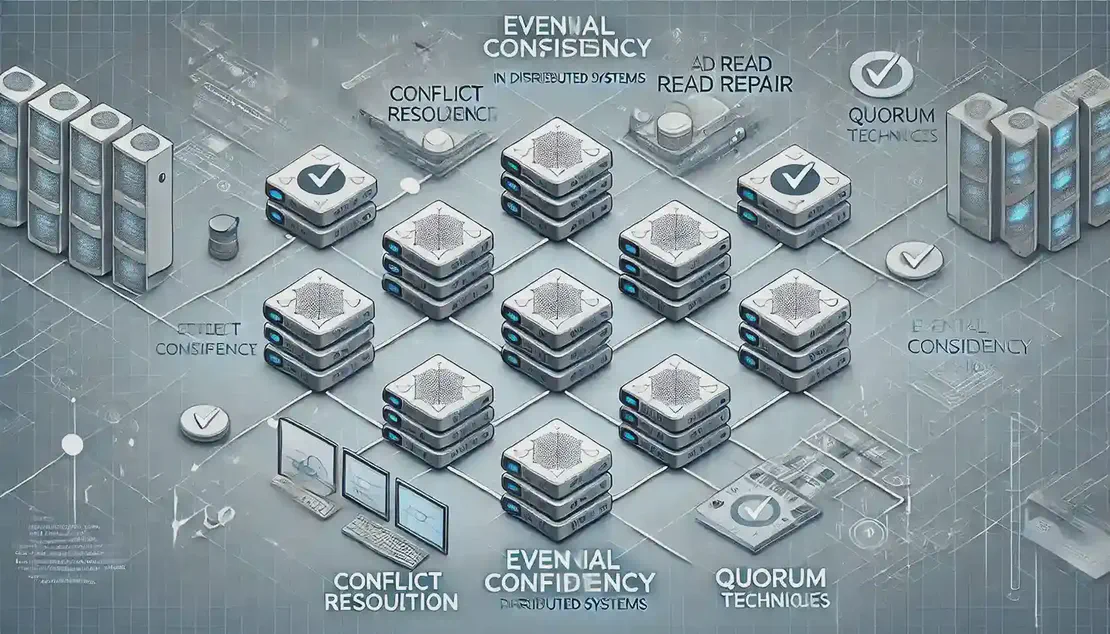
Eventual Consistency Patterns
- Vipul Kumar
- Eventual consistency , Distributed systems , Conflict resolution , Quorum
- December 17, 2024
Table of Contents
🔄 Event-Based Consistency — This pattern involves services emitting events when their state changes, and other services listening to these events to update their data. It promotes loose coupling and scalability but introduces a delay before all services reflect the latest state.
⏳ Background Sync Consistency — In this approach, a background job periodically synchronizes data between systems or databases. This method ensures consistency over time but can result in slower updates due to the scheduled nature of the synchronization.
🔗 Saga-Based Consistency — Sagas are sequences of local transactions where each transaction updates data within a single service. This pattern is useful for managing long-lived transactions and ensuring eventual consistency across distributed systems.
📚 CQRS-Based Consistency — Command Query Responsibility Segregation (CQRS) separates read and write operations into different models and databases. This allows for optimization of read and write operations independently, though it introduces eventual consistency between the two.
Event-Based Consistency
📡 Asynchronous Communication — Services communicate by emitting and consuming events asynchronously, often using message brokers like Apache Kafka or RabbitMQ.
🔗 Loose Coupling — This pattern promotes loose coupling between services, enhancing scalability and fault tolerance.
⏱️ Delay in Consistency — There is a delay before all services reflect the latest data, leading to eventual consistency.
⚡ Real-World Example — In a smart power grid system, services like billing and load balancing consume events from an energy meter service to update their databases.
🔍 Use Cases — Commonly used in systems where real-time data consistency is not critical, such as e-commerce platforms and monitoring systems.
Background Sync Consistency
🕒 Scheduled Synchronization — Data is synchronized periodically through background jobs or scheduled tasks.
📉 Slower Updates — This approach can result in slower updates as synchronization occurs at set intervals.
🔄 Consistency Assurance — Ensures data consistency across systems over time, despite the delay.
🔧 Implementation — Often used in systems where immediate consistency is not required, such as data warehousing and batch processing.
🔍 Real-World Example — Used in scenarios where data from multiple sources needs to be aggregated and synchronized periodically.
Saga and CQRS Patterns
🔗 Saga Transactions — Sagas manage long-lived transactions by breaking them into a series of local transactions, each updating data within a single service.
🔄 CQRS Separation — CQRS separates read and write operations into different models and databases, optimizing each independently.
📚 Read/Write Optimization — Allows for the independent optimization of read and write operations, improving performance and scalability.
🔍 Use Cases — Suitable for complex systems requiring high availability and scalability, such as financial services and e-commerce platforms.
⚙️ Implementation Challenges — Both patterns require careful design to handle eventual consistency and ensure data integrity.
Read On LinkedIn | WhatsApp | DEV TO | Medium
Follow me on: LinkedIn | WhatsApp | Medium | Dev.to | Github
Mastering Eventual Consistency Patterns in System ...
medium.com
Eventual Consistency is Tricky - by Saurabh Dashora
newsletter.systemdesigncodex.com
Pattern#1 - Event-based Eventual Consistency Services ...
threads.net
CQRS Eventual Consistency Event Dependencies
stackoverflow.com
Alex Xu's Post - systemdesign #coding #interviewtips
linkedin.com
Command-Query Responsibility Segregation (CQRS)
ibm-cloud-architecture.github.io
Handling Eventual Consistency in CQRS | by Vikas Agarwal
vikasrohit.medium.com
Pattern: Saga
microservices.io
Daniel Lambert, M.Sc. - Data Integration Patterns.
linkedin.com

